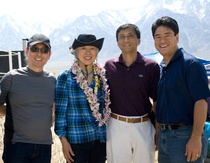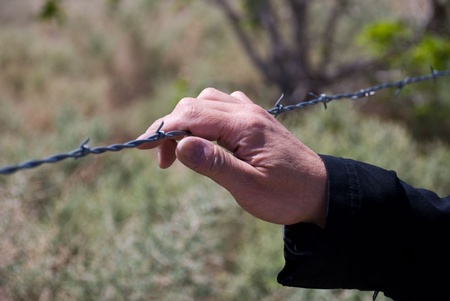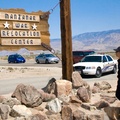Read Part 1 >>
Fast forward. April 28, 6 a.m. In the darkness of the L.A. morning I walk to the bus staging area at St. Francis Xavier Church. Body tired from the flight and time change, I chastise my pitiful self and think of the L.A. Times photo from 1942, which depicts the very same parking lot jam-packed with families and luggage. Bewildered, they have no idea what is in store for them or their children as armed soldiers look on. Although I feel solemn, I am greeted by a cheerful mix of former internees, descendants and others. There is a lovely group of former school teachers whose humor and brightness of spirit warms the chill of the L.A. morning. As we sit in the modern air conditioned bus, I close my jet lagged eyes. Images and feelings run wild as I imagine a 14 year old Ruthie sitting on the bus, wondering why they are leaving their home, and why all the shame and sorrow from the elders.
Bus pulls out and the sunrise kicks in. Eddie the driver snakes us through the canyons leading out of L.A. I can’t help but notice that it’s a magnificent day, but I try and keep my darkness intact for the Pilgrimage. Martha, our tour guide and schoolteacher, plays some enlightening videos about Executive Order 9066, and the heroic 442nd soldiers on the tiny video screens. My good friend and photographer Walter, whom I bribed to come along by promising to feed him for three days (works every time for bachelor dudes!), looks so serene as he snoozes the entire way.
Four hours and forty minutes later we arrive. Pulling off the highway, the first thing you see is the guard tower. Originally there were eight. The thought of a rifleman determining my perimeter makes my fists clench and back tighten up. As we exit the bus at the guard’s shack, I walk directly to the fence and squeeze the barbed wire in my hand. The pointed cold metal drives all of the “tourist” out of my system. Admittedly, I wanted to stir up some rage. Somewhere deep in my psyche, I carry this anger. I want to blame. I want to yell. But then I look up at some of the older Survivors walking about, and the stunning beauty of the Sierra Mountains forces some kind of serenity upon me. It’s not the volcanic outlet I was secretly seeking.
More buses and law enforcement vehicles arrive and I think about my mother, my Bachan, and Grandpa “Ojichan”—tying those cardboard name tags to their shirt buttons so that the soldiers could identify them. We re-board the bus to go deep into the property where the cemetery and stage is set up. We pass the gleaming new museum. A little further and three barracks appear. Wooden slat structures with tar paper covering. This is where our families were jammed into. Low, barn-like wooden structures with no inner walls that housed multiple families, 20 people in each. Common toilet outside, no personal privacy. I want to leap off the moving bus and go inside the barracks. Yes, I realize that they are re-creations but my illogical mind needs to go inside. The ceremony starts in a few minutes. The barracks will have to wait. I think of my Ojichan who I never met, shamed and dying behind barbed wire. One of 150 accelerated deaths, I believe.
Mother burns her pictures. Daddy burns inside.
He lashes out in tears of rage about
Basic freedom being denied
And through the paper walls the wind whips the skies
Blowing sand of pain into the babies eyes
So many miles from home this isn’t what we planned
We’ve become like strangers in our promised land
Liar. Let me out. There must be a mistake.
Liar. Let me out. How much more can the children take.*

Welcome by (l-r) Emcee Darrell Kunitomi, Monica Embrey and CAIR Leadership. Photo by Walter Tabayoyong
Kerry Cababa (also founding family) jumps aboard to warmly welcome the Pilgrims and I run off to rehearse for the sing-along. As I work my way toward the stage, I am stunned. People. Way over a thousand. Yes, a majority of Japanese Americans but also strong communities of Middle Eastern, Hispanic and other nationalities in support of human rights. I count 10 buses. Later Bruce Embry would tell me there officially was 1,270 people who came in from all over. Survivors, descendants, Buddhist, Christian, Muslim, Jewish and all those who need to remember what extreme racial profiling could lead to.

(l-r) Co-chair Kerry Cababa, Awardee Frank Hays and co-chair Bruce Embrey. Photo by Walter Tabayoyong
It is high noon now. Taiko drumming groups, including UCLA stir up the energy with their thunder. A multi-cultural welcome from Monica Embrey and a representative from the Islamic American community opens the program. Veteran Emcee Darrell Kunitomi guides us through the afternoon, which includes a welcome by Manzanar Superintendant Les Inafuku, awarding high profile leader Rose Ochi and Superintendant Frank Hays, a swinging tune by Manzanar songbird Mary Kageyama Nomura and a powerful talk by keynote speaker Dr. Mitchell Maki. Although I’m a city boy from Chicago who writes and performs on the very “edgy” side of things, I can say that it was so healing to help Nancy Gohata, Ken Koshio and Darrell lead the entire audience in Woody Guthrie’s “This Land is Your Land.” And I admit to having deep emotions as we sang Dylan’s “Blowin’ In the Wind” as survivors and descendants carried the huge banners with the names of the 10 concentration camps on them. Bruce Embry gives a passionate closing to the program.

(l-r) Ken Koshio, Nancy Gohata, Darrell Kunitomi and Keith Uchima lead Guthrie’s “This Land is Your Land.”

(l-r) Keith Uchima, Honoree Rose Ochi, Japanese Consul General Jun Niimi and Keynote Speaker Mitchell Maki. Photo by Walter Tabayoyong
*Excerpt from LIAR ©2001 Keith Uchima, Delectable Music (available on iTunes)
*This article was originally published on the Chicago Japanese American Historical Society website on May 27, 2012.
©2012 Keith Uchima








